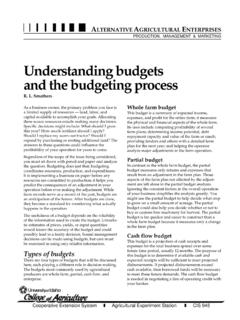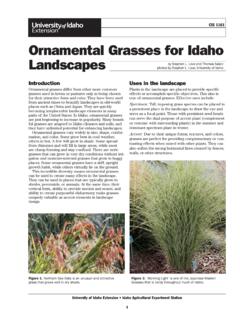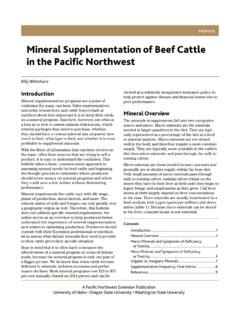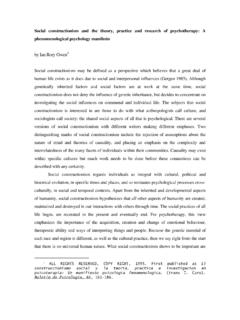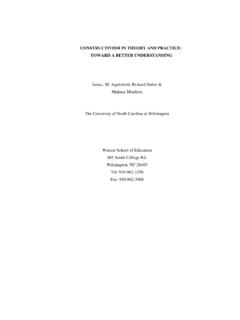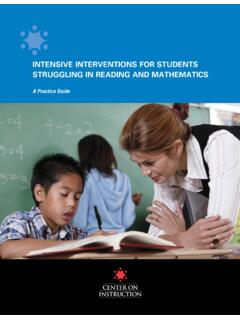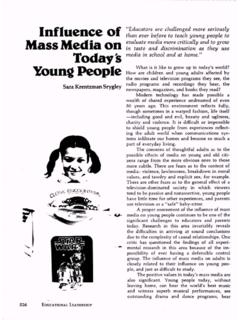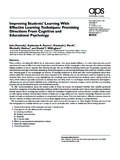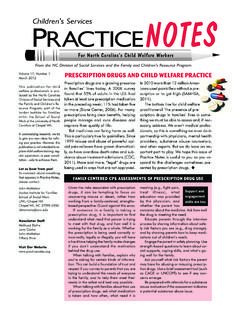Transcription of BUL 870 Methods for Conducting an Educational …
1 BUL 870. Methods for Conducting an Educational Needs Assessment Guidelines for Cooperative Extension System Professionals By Paul F. McCawley WHAT IS A NEEDS ASSESSMENT? ..p 3 4. WORKING GROUPS ..p 19. Direct and indirect assessments ..p 3 Uses of working groups ..p 20. Six steps for a needs assessment ..p 4 Facilitator role ..p 20. Objectives ..p 4 Nominal Group Technique (NGT) ..p 21. Describe the target audience ..p 5 Appropriate uses ..p 21. Materials and logistics ..p 21. INSTITUTIONAL APPROVAL ..p 5 Steps for Conducting NGT ..p 21. Introduction: Frame the question.
2 P 21. FOUR DATA COLLECTING Methods ..p 6 Brainstorm: the nominal phase ..p 21. Discuss: the clarification phase ..p 22. Samle procedure ..p 6. Decide: the voting phase ..p 22. Sample size, design ..p 6. Tips ..p 23. Table 1, Sample size for validity ..p 7. When to stratify sample ..p 7. REFERENCES ..p 23. 1. SURVEYS ..p 8. Written surveys, questionnaires ..p 8. Oral, telephone surveys ..p 8. Survey procedures ..p 9. Create survey instrument 14 steps ..p 9. Ten question-writing tips ..p 10. Pilot tests: Refine instrument ..p 10. Conduct survey ..p 11. Analyze data.
3 P 12. 2. INTERVIEWS ..p 13. Interview procedures ..p 13. Analyze interview data ..p 14. 3. FOCUS GROUPS ..p 14. Focus group procedures ..p 15. Choose a method ..p 15. Choose participants ..p 15. Logistics ..p 16. Describe questions, topics ..p 16. ABOUT THE AUTHOR. Select moderators ..p 17. Timeline ..p 17 Paul F. McCawley has served since 1999 as Associate Contact perspective participants ..p 17 Director of University of Idaho Extension. In 2004 he Participant incentives ..p 17 led development, implementation, and analysis of the Manage focus group sessions.
4 P 17 biggest survey in the history of University of Idaho Kinds of questions to ask ..p 18 Extension, a statewide survey to determine UI Exten- Analyze data ..p 18 sion's impact on the state and to determine greatest Analysis tips ..p 19 needs in the years ahead. PAGE 2. WHAT IS A NEEDS ASSESSMENT, AND WHY A needs assessment is conducted so the target audience CONDUCT ONE? can verify its own level of knowledge and skill, its inter- ests and opinions, or its learning habits and preferences. A needs assessment is a systematic approach to study- Collecting and analyzing needs assessment data allows ing the state of knowledge, ability, interest, or attitude the investigator to describe the gap between what of a defined audience or group involving a particular exists and what is needed.
5 Filling that gap becomes the subject. Cooperative Extension System professionals use purpose of the next generation of Educational services needs assessments to learn about important issues and and products. problems faced by our public in order to design effective Educational programs. Direct and indirect assessments Programs and products that specifically target docu- A direct needs assessment is accomplished through mented needs are inherently effective and marketable. A formal research that gathers data from clientele. An needs assessment also provides a method to learn what indirect approach uses secondary data or asks surrogates has already been done and what gaps in learning remain.
6 (advisors) for their opinions about priority needs and This allows the educator to make informed decisions issues. The direct assessment will result in data that is about needed investments, thereby extending the reach more specific to the needs of individuals, and it can be and impact of Educational programming. quantitative in terms of probability and confidence. However, direct research requires considerably more For extension, the goals of needs assessment are nearly resources to design and also requires institutional always the same. The first goal is to learn what our audi- approval to conduct.
7 Direct assessment should be ence already knows and thinks, so that we can deter- conducted periodically for major program efforts. mine what Educational products and services are needed. A second goal is to understand what we can do An indirect assessment can be conducted at any time to make our Educational products more accessible, when an advisory committee is meeting and does not acceptable, and useful to our clientele. require the same level of investment in the design, implementation, and analysis. However, even for a non- A needs assessment, thoughtfully performed, provides formal assessment, if the results are to be credible, the following: procedures must be followed, and findings must be carefully documented.
8 Impact. Insights about how education and training can impact your audience; Comprehensive needs assessment research helps docu- Approaches. Knowledge about Educational ment actual problems and deficiencies. With the needs approaches that may be most effective; assessment in hand, an educator can 1) verify and describe the current situation, 2) explain how the program will Awareness of existing programs and of gaps in avail- address that need, and 3) describe the expected impacts able training to enable efficient use of resources;. of the program ( , build a logic model).
9 Outcomes. Information about the current situation that can be used to document outcomes; A needs assessment allows educators to demonstrate the foundation for their logic model to potential partners Demand. Knowledge about the potential demand for or funders. Because most funding sources insist that a future programs and products;. project be evaluated, the information in a needs assess- Credibility that the program is serving the target audi- ment forms the basis for a program evaluation. When ence, an important part of communicating greater the intervention results in measurable change, project competence and professionalism to funding authori- managers will know whether they have succeeded and/or ties who want to know a program or product's impact.
10 Know what steps need to be taken next. PAGE 3. While goals for needs assessments are similar, the 7. Follow-up: What will you do with information that purposes to conduct needs assessments vary and will you gain? Data gathering Methods by themselves are influence how the project is approached. Extension is not a needs assessment. For the process to be required by statute to consider stakeholder input as part complete, the needs assessment has to result in of the design and delivery of programs. There are also decision-making. contractual agreements between state and local govern- ments that extension address locally relevant issues.
